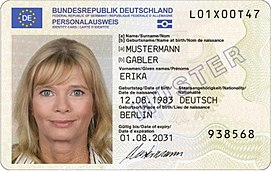European identity card
The European identity card[1][2] is an electronic identity document intended to replace and standardise the various identity card styles currently in use in the member states of the European Union and the European Economic Area.[lower-alpha 1] It was created by Regulation (EU) 2019/1157 of the European Parliament and of the Council of 20 June 2019 on strengthening the security of identity cards of Union citizens and of residence documents issued to Union citizens and their family members exercising their right of free movement, which is scheduled to enter into force on 2 August 2021.[3][4]
| European identity card | |
|---|---|
| Type | Electronic identity card |
| Issued by | |
| First issued | 2 August 2021 |
| Purpose | Access to unified identity document in any of the EEA member states |
| Valid in | |
| Eligibility | EEA citizenship |
Identity cards which do not meet the new requirements shall cease to be valid at their expiry or by 3 August 2031. However, identity cards which do not meet the minimum security standards or which do not include a functional MRZ shall cease to be valid at their expiry or by 3 August 2026. Identity cards of persons aged 70 and above at 2 August 2021, which meet the minimum security standards and which have a functional MRZ shall cease to be valid at their expiry.[5]

Common design and security features
Articles 3/4/5 of Regulation (EU) 2019/1157 state that:[5]
- Identity cards issued by Member States shall be produced in ID-1 format and shall contain a machine-readable zone (MRZ). Security standards shall be based on ICAO Document 9303.
- The document shall bear the title ‘Identity card’ in the official language and in at least one other official language of the institutions of the Union.
- It shall contain, on the front side, the two-letter country code of the Member State issuing the card, printed in negative in a blue rectangle and encircled by 12 yellow stars.
- It shall include a highly secure storage medium which shall contain a facial image of the holder of the card and two fingerprints in interoperable digital formats. The storage medium shall have sufficient capacity and capability to guarantee the integrity, the authenticity and the confidentiality of the data. The data stored shall be accessible in contactless form and secured as provided for in Implementing Decision C(2018) 7767.
- Identity cards shall have a minimum period of validity of 5 years and a maximum period of validity of 10 years. But Member States may provide for a period of validity of less than 5 years for minors and more than 10 years for persons aged 70 and above.
Notes
- The legal acquis has been identified as EEA-relevant by the EU, which makes it under scrutiny for incorporation into the EEA Agreement by Iceland, Liechtenstein and Norway.
References
- "The legal and political context for setting up a European identity document" (PDF). Directorate-General for Internal Policies. 2016.
- "Proposal for a REGULATION OF THE EUROPEAN PARLIAMENT AND OF THE COUNCIL on strengthening the security of identity cards of Union citizens and of residence documents issued to Union citizens and their family members exercising their right of free movement" (PDF). European Commission. 2018.
- "Regulation (EU) 2019/1157 of the European Parliament and of the Council of 20 June 2019 on strengthening the security of identity cards of Union citizens and of residence documents issued to Union citizens and their family members exercising their right of free movement". European Free Trade Association. Retrieved 16 June 2020.
- "Improving security for EU ID cards" (PDF). European Parliamentary Research Service. 2020.
- "EUR-Lex - 32019R1157 - EN - EUR-Lex". eur-lex.europa.eu. Retrieved 13 September 2019.
External links
| Wikimedia Commons has media related to European identity card. |
- Regulation (EU) 2019/1157 of the European Parliament and of the Council of 20 June 2019 on strengthening the security of identity cards of Union citizens and of residence documents issued to Union citizens and their family members exercising their right of free movement
- National identity cards in PRADO (The Council of the European Union Public Register of Authentic Travel and Identity Documents Online)